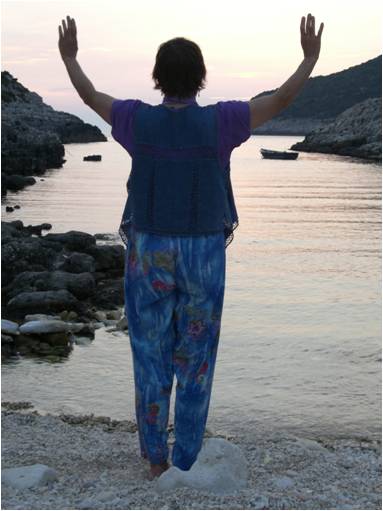Meditation covers a number of techniques and it has been scientifically proven that any form of regular meditation calms the mind, reduces anxiety, stress and depression. Meditation enhances happiness, health and vitality. Ask anyone who meditates and they’ll tell you it makes them feel more peaceful, healthier and energetic.
On the physical level, it lowers the risk of heart diseases, reduces blood pressure and brings relief from asthmatic problems, chronic fatigue, ME and migraines.
Whilst meditating, brainwaves change to a unique pattern which is associated with deep relaxation, this peaceful yet aware state is the aspect that distinct meditation from sleep or hypnosis, allowing breathing to slow, blood pressure to drop and your body to rest.
Meditation generally focuses on something in the present, such as your breath or a mantra. When we focus on a single word, thought or image, we close down the internal babble that fills our brains and create instead a state of tranquillity that increases our mental alertness, while soothing the other systems in our body.
Breathing is something we take for granted and do thousand of times a day without even thinking about it. And this is precisely the problem, we never stop and think how remarkable and valuable the breath is in giving our body the oxygen and energy it needs. Stressful modern lifestyles mean that many people have a habit of taking only shallow breaths, which don’t properly energise the body properly. Breathing can be used as a means to enhance health, helping to ease fatigue, panic and stress.
Its well worth sparing 5 minutes daily, preferably outside in the fresh air, taking deep breaths, right down to the diaphragm so your whole chest cavity expands in all directions like a balloon being inflated permitting all of your lungs to fill with air. qigong and yoga exercises are excellent for this.
During meditation, the governing left part of the brain, linked with verbal, analytic and rational thought, becomes less active, and the right hemisphere, linked to intuition, creativity and emotion, increases activity. This readjusting appears to reduce the demands being processed by the brain, so the body balances and immune functions therefore are boosted.
To meditate successfully all you need is the will, self-discipline and enthusiasm to practice daily. You don’t have to be religious to meditate and anyone can learn. Although it is an ancient spiritual discipline, it belongs to no specific religion.
You can meditate while sitting, walking or practising qigong or yoga, but it’s easiest when sitting at ease on a chair in a peaceful room for 5-20 minutes, twice a day, every day. While some people learn from a book, tape, CD or video, most benefit from the direct guidance of an experienced teacher. It’s really a question of what works for you. You can enhance the experience by using gentle peaceful music, chimes or bells, and also candles and incense.
Some types of meditation
Guided Meditation by a teacher (or tape), passive meditation helping you relax listening to the voice talking taking, endeavours to help you find clearness of thought, inner peace and will aid your visualisation progress.
Meditation in movement through the daily practice of the art of tai chi or qigong will suit those who struggle to sit still.
Buddhists meditation has several variations such as: Samatha meditation – awareness of the mind on an object like the tranquillising rhythm of the breath. Vipassana meditation – insight meditation, watching an inward ‘cinema’ to understand the way things are. Jongron meditation – walking mindfully. The Matta Bhavana focuses on a happy event that you extend to yourself and others, etc.
Meditation in action – mindfulness – experience being fully aware of living in the present moment, increasing your sensitivity of your senses and your observation skills.
Chakras meditation exploring the seven main energy centres in the body, their colours, sounds, attributes, etc.
TCM Five Elements meditation exploring the 5 Chinese Traditional Chinese Medicine Elements, their colours (red, yellow, white, blue & green) the 6 sounds and associated organs. Experiencing the flow of energy along the meridian lines.
Tai Chi & Qigong practices are moving meditation when done with the mind, body & spirit in comple awareness and harmony during ones practice.
Silent group walking meditation helps focus your attention inwards and will again suit those who struggle to sit still. It intensifies awareness of all the sounds, sights and smells of the nature around you. It can be done with any number of people. Be aware of the group as a whole and the ground you are walking on and breathe only through the nose.
Observation meditation such as watching the flame of a candle, a flower, the photo of a spiritual master, a mandala, observing the breath or meditating on an abstract subject.
Affirmations can be used on a daily basis to create a positive attitude to life, improve confidence and self-worth. Keep sentences short and positive such as: ‘I am confident’, ‘I am happy and at peace’, etc.
Clinically Standardised Meditation (CSM) was created by psychologist Dr Patricia Carrington and developed to be straightforward enough for anyone to use. Built on traditional techniques, it uses the simple focal point of a mantra. You can chose your own mantra, a word like ‘peace’, ‘gentle’ or other eastern sounds. The technique is adaptable and designed to work with individual needs and ways of life.
The Respiratory One Method was developed by Dr Herbert Benson and other meditation researchers. The One Method concentrates on your breathing and repetition of the word ‘one’ in your head as you exhale.
Transcendental Meditation (TM) is a mantra meditation where a word is repeated either aloud or mentally. The word is chosen for you, rather than you making your own choice – I do not recommend this one, you should always know what you are saying.
Helpful tips
- Make time for your meditation and to get the most out of it try to meditate at least for 5-20 minutes, twice a day.
- Find a peaceful place where you won’t be disturbed and sit comfortably, if you lie down you may feel sleepy. Sit cross-legged on a cushion on a mat or on a straight-backed chair if it’s easier.
- Relax and close your eyes, your breathing should slow down and soften. Clear your mind of anxieties and, as you breathe out at first, sigh to release any tension in your body.
- Quieten your mind and focus on your mantra or breath, and let it take all your attention. If you are using your breath as a focus, use the method of your choice, such as the Respiratory One method or counting to four as you inhale and again to four as you exhale and repeating for as long as you wish to meditate. Most people focus on their breath or mantra. ‘Om’ is a Hindu mantra, but you could choose a word like ‘love’, ‘light’, ‘relax’, ‘calm’ or ‘peace’ or a word from your own faith.
- Focus your mind and don’t force your brain to concentrate, just let it relax on your mantra or breath. Let invasive thoughts drift by and calmly return your focus. Breathe naturally. Passively ignore all other invasive thoughts or disruptions. Don’t push them away – just let them drift through without paying them any attention.
- When you’re ready to end your meditation, slowly return your focus to your surroundings and stretch gently. Accept that you may not succeed straight away, but you’ll get better with practice. Daily practice is crucial to succeed but only spend as long as you can on it.


